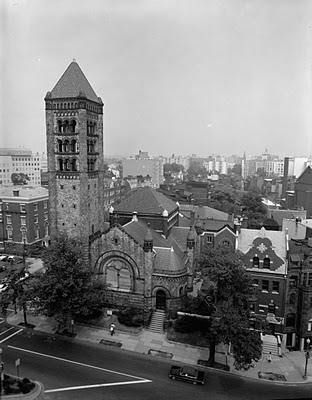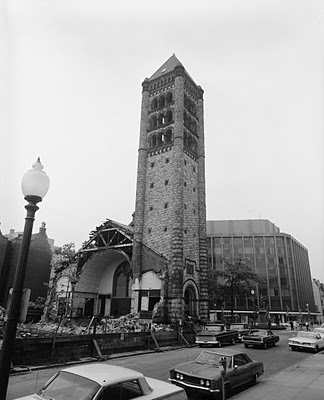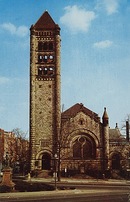Lost Washington: Church of the Covenant
Churches are one of the biggest challenges for historic preservation. They are such unique structures and so poorly suited to be anything but what they are. What happens when a congregation outgrows its building and wants to move on?
In some cases, old churches downtown have been preserved because they were taken over by other religious groups. Several downtown landmarks have survived that way. The Washington Hebrew Synagogue was built in 1898 near 8th and I Streets NW and became the Greater New Hope Baptist Church in 1955.
The Adas Israel Synagogue, built in 1907 at 6th and I, was turned over to the Turner Memorial African Methodist Episcopal Church in 1951 before being converted back to a synagogue in 2004. However, such reuse doesn’t always pan out.
One of the city’s greatest losses in historic religious structures was the old National Presbyterian Church, originally called the Church of the Covenant, which used to rise from the southeast corner of Connecticut Avenue and N Street NW. The building, which James M. Goode has called a “dignified masterpiece in gray granite,” was completed in 1889 and torn down in 1966, to be replaced by a nondescript office building.
The church was designed by New York architect J.Cleveland Cady (1837-1919), a devout Presbyterian who is best known for designing part of the American Museum of Natural History in New York City.
For this building, Cady adopted the Romanesque Revival style popular in the late Victorian era, replete with heavy rounded arches and rough-cut stone facing. H. H. Richardson’s celebrated Allegheny County Courthouse had just been completed in Pittsburgh in 1886, and it clearly influenced both this building and W.J. Edbrooke’s grand Post Office Department building on Pennsylvania Avenue, another great DC landmark in this style.
In the early 1880s, members of the New York Avenue Presbyterian Church near the White House had decided they needed to reach out to the far northwest part of the city (i.e., around Dupont Circle) to keep up with the wealthy “top hats” that increasingly were moving out to that wealthy suburb. They founded the Church of the Covenant in 1883 and built a small chapel on N Street in 1884.
Construction of the main church began in 1887 and was nearly complete when the 158-foot Ohio-sandstone tower suddenly collapsed into a heap of rubble early on the morning of August 22, 1888. Cady’s Washington representative, Robert I. Fleming, had been on hand the day before to inspect construction progress and realized the tower was in jeopardy when a large crack appeared in one wall.
Fleming ordered the site watchman, Thomas Neal, to keep people away for their own safety. Neal told the Washington Critic that he heard cracking sounds coming from the tower at regular intervals beginning around 10 o’clock that night. A policeman making his rounds around 4:30 the next morning noticed the strange noises and was about to go inside to investigate when Neal warned him away just before the whole thing fell to the ground.
The Washington Post reported that “The crash and falling stones was like a peal of thunder, and before it ceased a cloud of white dust rose from the ruins, completely enveloping the building and hiding it from the view of the two startled spectators. Long before the air became clear the whole neighborhood was aroused. Windows were thrown open and scantily-clad figures ran from the houses, under the impression that there had been an earthquake.”
What caused the collapse? Fingers were pointed in all directions. “It was the fault of the contractor; it was the fault of the architect; it was the fault of the trustees, of the material, of the mortar, of everything and of nothing,” the Post reported with exasperation.
An official investigation soon concluded that the basic design was sound but that inferior materials and workmanship were to blame for the accident. The mortar, in particular, was found to be “practically worthless.” The architect, contractors, and Church congregation agreed to divide the cost of reconstruction equally, and a new and very solid tower was soon standing.
The finished church was an exquisite homage to its Byzantine as well as Romanesque forbears. The squarish interior spaces were defined by sweeping vaults with elaborate plasterwork ceiling decoration. The central nave was crowned by a massive square “lantern” with clerestory windows allowing light to shine in from the heavens. On three sides, stained glass windows made by the New York firm of Tiffany and Booth illustrated the life of Christ.
Finally, in the center was a grand, gas-powered brass chandelier, 15 feet wide, that was paid for with monies donated by the children of the church’s Sunday school classes. The impressive Byzantine-style chandelier was made in Philadelphia and inspired by a similar fixture in the Hagia Sophia in Constantinople. It contributed to the church’s reputation as the “Hagia Sophia of Washington.”
The new church prospered and grew, especially after it absorbed the congregation of the historic First Presbyterian Church, which was located on John Marshall Place near the old DC Courthouse. The city government used eminent domain to seize that property in 1930 to provide space for a municipal complex. The Connecticut Avenue church was renamed the Covenant-First Presbyterian Church to recognize the merger of the two congregations.
Already by that time, a sense had been developing among at least some of the church’s leaders that the building on Connecticut Avenue was not enough. Other faiths had national churches in Washington, and some Presbyterians wanted a national church as well — something with sufficient accommodations to serve as a national center.
But the sentiment was not unanimous. After all, as David R. Bains has pointed out, an essential tenet of Presbyterianism is the equality of ministers, elders, and congregations. The idea of one particular congregation having a special status as the national church went against the grain. Yet the desire for a national church persisted.
In the 1927 a design was prepared for a sprawling Spanish Gothic-style church complex to be built in Woodley Park, on a site acquired from developer Harry Wardman for $100,000. The ensuing stock market crash put an end to that idea, and the property was sold back to Wardman; the Shoreham Hotel stands there today.
Despite this false start, plans for a national church continued to advance. A major step occurred in October 1947 with a ceremony attended by President Harry Truman marking the official establishment of the Connecticut Avenue church as the National Presbyterian Church. After the unveiling of a plaque on the front of the church, Truman and his family were seated inside in the Presidential pew, which had been taken from the old First Presbyterian Church and had previously seated Presidents Jackson, Polk, Pierce, Buchanan, and Cleveland. Later President Eisenhower would attend this church as well, although he chose not to sit in the traditional Presidential pew, according to a 1953 article in The Washington Post, because it had an obstructed view.

Photo from the Historic American Buildings Survey.
Meanwhile, the quest for a larger church complex went on. A proposal was made in 1954 to construct a church building across N Street on a lot then being used by the church for parking, with an underground tunnel to connect the new building to the old church. However, this plan didn’t include adequate parking and was ultimately found to be too costly, so the search for a new location continued.
A site at Massachusetts and New Mexico Avenues NW — the former estate of banker Charles C. Glover, Sr. — was purchased in 1959, and a preliminary design was developed by architect Edward Durrell Stone (1902-1978) for a grand, $20 million, modernist church complex there. This time church officials cringed at the expensive, cathedral-like pretensions of the Stone design, and it was dropped in favor of a more modest plan by Philadelphia ecclesiastical architect Harold E. Wagoner.
In August 1963, church officials announced that they had signed a contract to sell the old church building on Connecticut Avenue for $2.6 million to a developer who planned to raze it and put up a much-more-profitable 10-story office building in its place. It didn’t take long for protests to develop. In October, the chair of the National Capital Planning Commission, Elizabeth Rowe, was reported in the Post as expressing grave concerns about tearing down the church, which she called “a landmark of the highest significance, both historically and architecturally.”
This prompted the Post‘s architecture critic, Wolf Von Eckardt, to bemoan the fact that no one seemed willing to do something to stop the loss of the landmark building, which represented for him the only structure of distinction still left on Connecticut Avenue. “No office slab could possibly adorn that multiple intersection as well as that cheerful exclamation mark of a tower, nor give it as much poetry as that well-shaped rough stone heap.”
In his rambling article, Von Eckardt claimed that other churches had been shut out of bidding on the building for their own use. He quoted the church’s pastor as saying “No other denomination may use a Presbyterian building!” (According to J. Theodore Anderson, the church in fact tried to identify other congregations that might want the building but could find none.)
After dismissing the historic preservationists of his day as “mainly a movement of noble and hopeless protest,” Von Eckardt presciently summed up the issues at stake, then as now: “Obviously, sentiment is not enough. Not all old buildings are worth preserving. And not all buildings worth preserving can realistically be preserved. But greater efforts must be made. At stake are not only the landmarks themselves, but the city and not only the image and appearance of the city, but urban economics as well.”
The fight was on, and it continued for three more years. Robert R. Garvey, Jr., head of the National Trust for Historic Preservation, called the planned demolition a “catastrophe,” though he recognized that, with no historic preservation laws yet on the books, he had little power to stop it. The Association for the Preservation of the 1700 Block of N Street was organized and staged a number of protests.
Feeling the pressure, Presbyterian Church leaders called a press conference in 1964 to explain why they needed to proceed with their plans: they had been working on the move for many years, the old church was inadequate for their needs, and the sale of the old property was essential to help fund the new complex.
The preservationists were unmoved. The property had been rezoned to allow for construction of the planned 10-story office building, so the N Street group and others sued to overturn the rezoning. However, the court sided with the church.

The great chandelier downed and ready for removal. Photo from the Historic American Buildings Survey.
With no viable options left, in July 1966 the building came down. Workmen first removed the Tiffany stained glass windows, the historic pews that Presidents had sat in, and the great chandelier paid for by the Sunday school children.
The Postreported that on one day passersby were sent scurrying by a wall that tumbled down unexpectedly during the demolition. This was a brick wall in an adjoining structure, not the solid granite walls of the church itself. In fact, according to J. Theodore Anderson, the church’s iconic tower, which had been so poorly constructed the first time around, proved particularly obstinate when the wreckers attacked it 78 years later.

Demolition underway in 1966. Photo from the Historic American Buildings Survey.
Out on Massachusetts Avenue, the ground had been found unsuitable for the planned church complex, and a new site, at 4123 Nebraska Avenue NW — the former Hillcrest Children’s Center — was obtained in January 1966.
The following year construction began on a modernist limestone church and center, with slim Gothic-inspired arched windows. Buildings formerly used by the children’s center were also renovated for use as part of the church complex. The new church had its first services in September 1969.


Left: Before demolition. Photo from the Historic American Buildings Survey.
Right: The same view today. Photo by the author.
Meanwhile, back on Connecticut Avenue, a bland 1960’s office box was indeed erected on the site of the Church of the Covenant, although it was only 8 stories instead of 10. In 2007, that building was stripped down to its concrete frame and re-sheathed in contemporary tinted glass.
Special thanks to J. Theodore Anderson, Director of the National Presbyterian Church Library and Archives for his invaluable assistance. Other sources included David R. Bains, “A Capital Presence: The Presbyterian Quest for a ‘National Church’ in Washington, D.C.” (2006); James M. Goode, Capital Losses (2003); Albert Joseph McCartney, “The National Presbyterian Church and Its Heritage in Washington” in Records of the Columbia Historical Society, Vol. 60/62 (1962); The National Presbyterian Church, The National Presbyterian Church: The First 200 Years 1795-1995; and numerous newspaper articles.
Cross-posted at Streets Of Washington.



